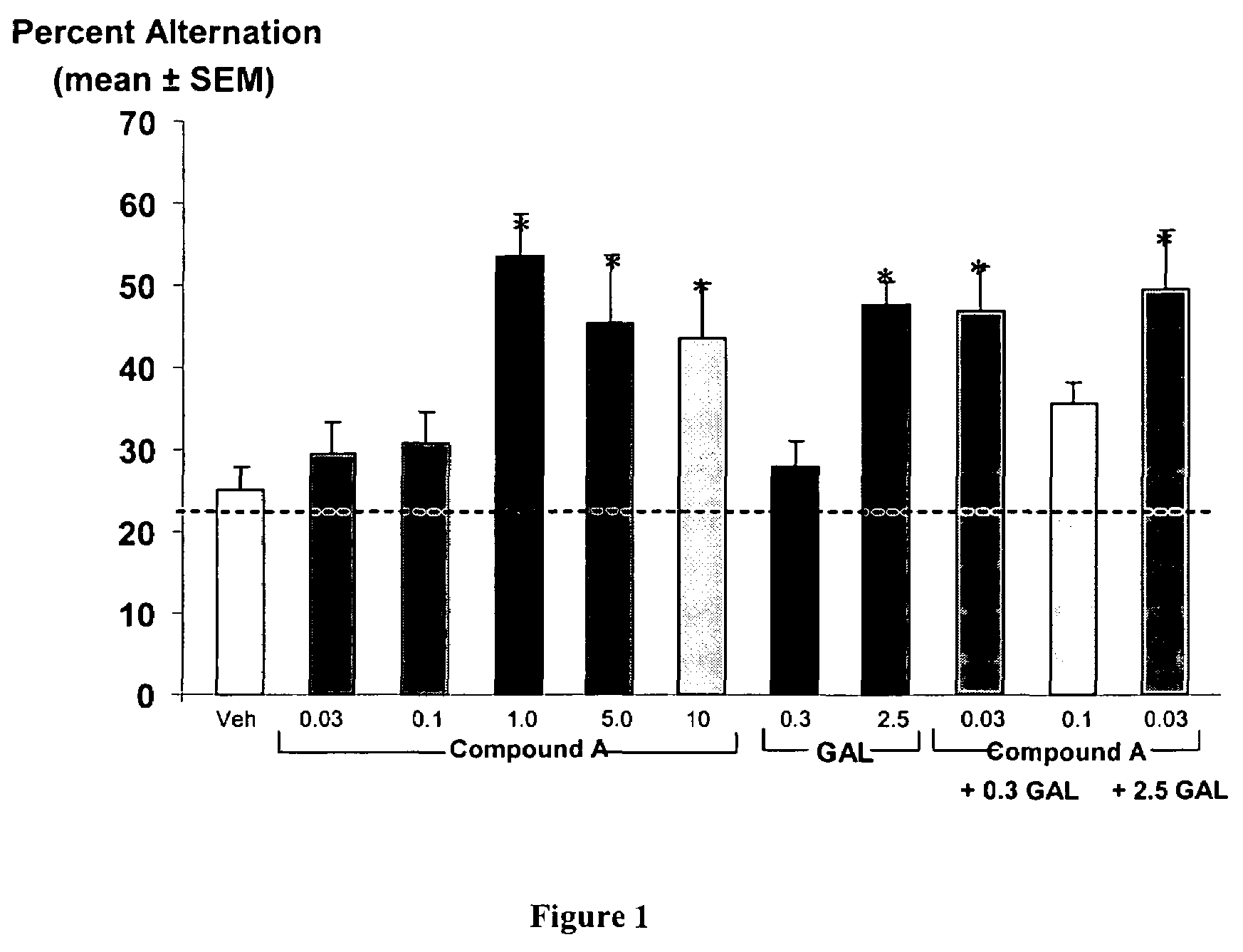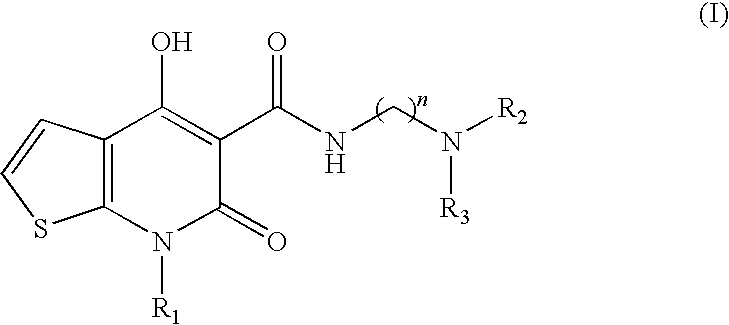Compositions and methods for treating CNS disorders
a technology of cns and compounds, applied in the field of new, thienopyridinone compounds, can solve the problem of not substantially enhancing memory
- Summary
- Abstract
- Description
- Claims
- Application Information
AI Technical Summary
Benefits of technology
Problems solved by technology
Method used
Image
Examples
example 1
[0103]This example demonstrates that a combination therapy including 6,7-dihydro-4-hydroxy-7-isopropyl-6-oxo-N-(3-(piperidin-1-yl)propyl)thieno[2,3-b]pyridine-5-carboxamide, a partial 5-HT4 receptor agonist and galanthamine hydrobromide, an acetylcholinesterase inhibitor, both in suboptimal doses, enhance delayed spontaneous alternation performance, a yardstick for determining memory enhancement.
[0104]In the spontaneous alternation test a rat is allowed to freely explore all arms in the maze. There is no explicit positive reinforcement, e.g., receiving a sweetened cereal piece when entering an arm. Instead, the test takes advantage of a rat's natural exploratory behavior. In particular, the test takes advantage of a rat's bias to choose the least recently visited arm in navigating among a restricted number of arms in a maze (Dember & Fowler, 1958). In order for a rat to choose the least recently visited arm it must remember which arms it entered most recently. Therefore, this task h...
example 2
[0118]This example demonstrates that suboptimal doses of Compound A and galanthamine in combination enhance spatial memory.
Subjects
[0119]Male Long-Evans rats (Charles River Laboratories, Indianapolis, Ind.) weighing between 350 and 400 grams at the time of testing were used for all experiments. Subjects were individually housed in plastic cages in a temperature controlled room with a 12 hour light:dark cycle (lights on a 7:00 h). Rats had free access to food and water except for the 24 hours preceding testing, at which time they were restricted to approximately 12 grams of food. The experiments were conducted in accordance with the United States government principles for the utilization and care of vertebrate animals used in testing, research, and training.
Apparatus
[0120]The delayed spontaneous alternation task was tested on a four-arm cross maze made of 0.6 cm thick black plastic. The maze was placed on a table that was 75 cm above the floor. Each arm of the maze was 55 cm long and...
example 3
[0127]This example demonstrates the effect of much larger doses of Compound A on hippocampal acetylcholine levels in rats during delayed spontaneous alternation.
Subjects
[0128]Male Long-Evans rats (Charles River Laboratories, Indianapolis, Ind.) weighing between 350 and 400 grams at the time of testing were used for all experiments. Subjects were individually housed in plastic cages in a temperature controlled room with a 12 hour light:dark cycle (lights on a 7:00 h). Rats had free access to food and water except for the 24 hours preceding testing, at which time they were restricted to approximately 12 grams of food. The experiments were conducted in accordance with the United States government principles for the utilization and care of vertebrate animals used in testing, research, and training.
Apparatus
[0129]The delayed spontaneous alternation task was tested on a four-arm cross maze made of 0.6 cm thick black plastic. The maze was placed on a table that was 75 cm above the floor. E...
PUM
| Property | Measurement | Unit |
|---|---|---|
| pH | aaaaa | aaaaa |
| pH | aaaaa | aaaaa |
| pH | aaaaa | aaaaa |
Abstract
Description
Claims
Application Information
 Login to View More
Login to View More - R&D
- Intellectual Property
- Life Sciences
- Materials
- Tech Scout
- Unparalleled Data Quality
- Higher Quality Content
- 60% Fewer Hallucinations
Browse by: Latest US Patents, China's latest patents, Technical Efficacy Thesaurus, Application Domain, Technology Topic, Popular Technical Reports.
© 2025 PatSnap. All rights reserved.Legal|Privacy policy|Modern Slavery Act Transparency Statement|Sitemap|About US| Contact US: help@patsnap.com



